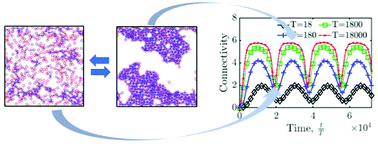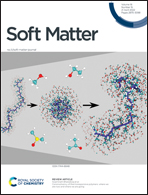Sustained order–disorder transitions in a model colloidal system driven by rhythmic crosslinking
Abstract
Biological systems have the unique ability to self-organize and generate autonomous motion and work. Motivated by this, we investigate a 2D model colloidal network that can repeatedly transition between disordered states of low connectivity and ordered states of high connectivity via rhythmic binding and unbinding of biomimetic crosslinkers. We use Langevin dynamics to investigate the time-dependent changes in structure and collective properties of this system as a function of colloidal packing fractions and crosslinker oscillation periods and characterize the degree of order in the system by using network connectivity, bond length distributions, and collective motion. Our simulations suggest that we can achieve distinct states of this colloidal system with pronounced differences in microstructural order and large residence times in the ordered state when crosslinker kinetics and lifetimes depend directly on the oscillation period and this oscillation period is much larger than the colloidal diffusion time. Our results will provide insights into the rational design of smart active materials that can independently cycle between ordered and disordered states with desired material properties on a programmed schedule.



 Please wait while we load your content...
Please wait while we load your content...